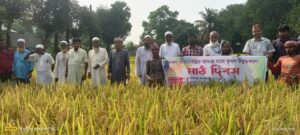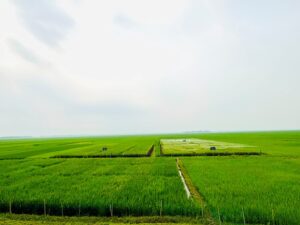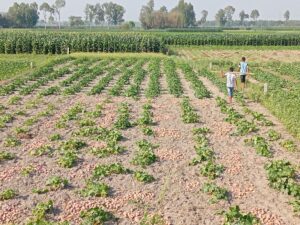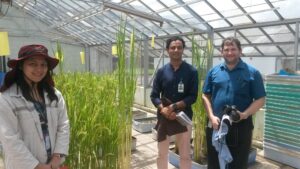
Farmers need not crack rice between their teeth to check whether the grains are dry enough for milling and storing because gauging the dryness of the grains no longer needs to be hit-and- miss. They can now be sure of the moisture content of their paddy because the International Rice Research Institute (IRRI) has found an affordable alternative.
After searching high and low and after many discussions with several electronics manufacturers in the Philippines, Cambodia, and India, IRRI scientists finally found an industry partner to produce and commercialize a low-cost moisture tester.
With the new IRRI moisture tester, farmers can benefit by making more-informed decisions on safely storing their harvest. And, they will have more negotiating power when they sell the paddy to traders.
Compared with previous versions, which were made by two small cottage industry workshops in Los Baños, Laguna, in the Philippines, the new device is equipped with improved electronics using state-of-the-art processes of the Manila-based Nanodevice Technologies, Inc. The tester now also comes with a warranty.
Moisture testing is important to farmers so they can check whether or not the paddy is dry enough, and can be stored safely. Also, when storing seeds in airtight storage systems, the IRRI moisture tester will help determine the seed moisture content before the storage container is sealed.
This new device has three lightemitting diodes (LEDs) and a beeper to visualize the results: red, green, and yellow. Red indicates that the paddy is still too wet (above 14%) and needs to be dried, green means the paddy is dry enough for safe storage and at optimum moisture content for milling (12–14%), and yellow indicates the paddy is ready to be distributed as seed or is safe for seed storage (less than 12% moisture content).
Moisture content can be determined at a resolution of 1% within a range of 10–16% by observing the pattern of lights. The accuracy within this range is similar to that of a digital resistance-based moisture meter, which typically costs US$200–400. This affordable moisture tester is kept as simple as possible to keep the cost down, so it does not have a digital display.
It is always a challenge to leap from solid research results to commercially viable products because of the initial investment needed for adaptive R&D to develop something that can be mass-produced.
By pooling resources from the Asian Development Bank and the Irrigated Rice Research Consortium (IRRC) among other sources, IRRI was able to place an initial order of 350 units, which was sufficient for Nanodevice to be interested in conducting the R&D and to be able to replace expensive circuits imported from developed countries with cheaper components from China and to redesign the electronics to allow for a more automated production line.
Because of the small initial order volume and the development cost, the price tag is still relatively high. Hence, the 350 units are being distributed strategically to further develop the market for a larger order. Some will be sold through IRRI at a subsidized price of $55. Once orders reach 10,000 units, the price per unit may come down to $35. Further streamlining and improvements, such as investing in a mold for a custom housing, could lead to even lower prices.
Small orders of the moisture tester can be placed at the IRRI Riceworld Bookshop. For larger quantity orders, please contact Nanodevice Technologies, Inc., at tel. no. (63) 2 477-1379, telefax (63) 2 470-6485. For more information, email IRRI Postharvest unit.
Why moisture content must be just right

Checking the moisture content of the grain is important in rice production because high moisture will create problems for farmers, especially during postharvest activities.
- Heat buildup. The natural respiration of stored wet grain can generate excessive heat. Heat,combined with high humidity, provides excellent growth conditions for molds and insects and will thus contribute to grain deterioration.
- Mold growth. Molds propagate diseases and may also release toxins into the grain. Although some mold-causing fungi may be present in the grain at harvest time, a safe moisture content can impede mold development. If the fungi are in the mycotoxin-producing family, rice can be unsafe for both human and animal consumption.
- Insect infestation. Insect infestation is always a problem in storage facilities in tropical climates, even if the grain is completely dry. However, with less moisture content in the grain, insect problems will probably be fewer. A combination of proper drying procedures and storage practices, including storage hygiene, will keep insect infestation at acceptable levels.
- Loss in seed germination. High moisture will also gradually reduce germination ability if the stored grain is destined to be used as seed.
- Rice of less value. Heat buildup in stored rice due to a combination of insects, molds, and/or high humidity often leads to a musty odor, which will considerably reduce the grain’s market value. Heat buildup also results in a general yellowing of the grains. Discolored grain drastically reduces market value since whiteness is important to rice consumers.
- Reduced head rice recovery. Fissuring or cracking of rice grains can occur when individual grains that were already dried reabsorb some moisture. This happens either when wet grain is mixed with dry grain or when dry grain is exposed to ambient air that has more moisture in it than the grain does. During milling, this fissuring reduces the recovery of head rice, which refers to the whole grains of milled rice that can be obtained from a given quantity of clean paddy. On the other hand, if rice is overdried, that is, more water than necessary is removed, it will weigh less. Since rice is sold by weight, sellers’ profits will be less. In addition, rice grains that are too dry are more brittle and more likely to break in the milling process, again reducing head rice recovery.
Source: Rice Knowledge Bank
_________________________________________
Mr. Martin Gummert and Dr. Paterno Borlagdan are mechanization and postharvest experts at IRRI.










